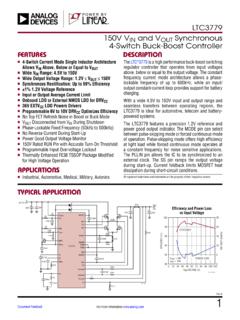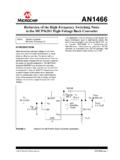Transcription of Design Calculations for Buck-Boost Converters …
1 Application Report SLVA535A August 2012 Revised September 2012 1 Design Calculations for Buck-Boost Converters Michael Green Advanced Low Power Solutions ABSTRACT This application note gives the equations to calculate the power stage of a non-inverting Buck-Boost converter built with an IC with integrated switches and operating in continuous conduction mode. See the references at the end of this document if more detail is needed. For a Design example without description, see appendix A. Contents 1 Basic Configuration of a buck boost converter .. 2 Necessary Parameters of the Power Stage .. 2 2 Calculating the Duty Cycle .. 2 3 Inductor Selection.
2 3 buck Mode .. 3 boost Mode .. 3 4 Calculating Maximum Switch 4 buck Mode .. 4 boost Mode .. 5 5 Output Voltage Setting .. 5 6 Input Capacitor Selection .. 7 7 Output Capacitor Selection .. 7 buck Mode .. 7 boost Mode .. 8 9 Appendix A. Design Example Using TPS63020 .. 10 System Requirements .. 10 Duty Cycle .. 10 Inductor Selection .. 10 Maximum Switch Current .. 10 Output Voltage Setting .. 10 Input Capacitor Selection .. 10 Output Capacitor Selection .. 11 Figures Figure 1. buck boost converter Schematic .. 2 Figure 2. Feedback Circuit .. 6 SLVA535A 2 Design Calculations for Buck-Boost Converters 1 Basic Configuration of a buck boost converter Figure 1, shows the basic configuration of a Buck-Boost converter where the switches are integrated in the IC.
3 Many of the Advanced Low Power Buck-Boost Converters (TPS63xxx) have all four switches integrated in the IC. This reduces solution size and eases the difficultly of the Design . Necessary Parameters of the Power Stage The following four parameters are needed to calculate the power stage: 1. Input voltage range: Vinmin and Vinmax 2. Nominal output voltage: Vout 3. Maximum output current: Iout 4. Integrated circuit used to build the Buck-Boost converter . This is necessary because some parameters for the Calculations must be derived from the data sheet. If these parameters are known, the power stage can be calculated. 2 Calculating the Duty Cycle The first step after selecting the operating parameters of the converter is to calculate the minimum duty cycle for buck mode and maximum duty cycle for boost mode.
4 These duty cycles are important because at these duty cycles the converter is operating at the extremes of its operating range. The duty cycle is always positive and less than 1. (1) (2) Where: Figure 1. buck boost converter Schematic SLVA535A Design Calculations for Buck-Boost Converters 3 Vinmax = maximum input voltage Vinmin = minimum input voltage Vout = desired output voltage Dbuck = minimum duty cycle for buck mode Dboost = maximum duty cycle for boost mode = estimated efficiency at calculated Vin, Vout, and Iout 3 Inductor Selection Data sheets often give a range of recommended inductor values.
5 If this is the case, choose an inductor from this range. The higher the inductor value, the higher is the possible maximum output current because of the reduced ripple current. Normally, the lower the inductor value, the smaller is the solution size. Note that the inductor must always have a higher current rating than the largest value of current given from Equations 5 and 8; this is because the peak current increases with decreasing inductance. For device datasheets, where no inductor range is given, an inductor that satisfies both buck and boost mode conditions must be chosen. Follow both sections and to find the right inductance. Select the largest value of inductance calculated from either equations 3 and 4.
6 buck Mode For buck mode the following equation is a good estimate for the right inductance: (3) Where: Vinmax = maximum input voltage Vout = desired output voltage Iout = desired maximum output current Fsw = switching frequency of the converter Kind = estimated coefficient that represents the amount of inductor ripple current relative to the maximum output current. A good estimation for the inductor ripple current is 20% to 40% of the output current, or < Kind < boost Mode For boost mode the following equation is a good estimate for the right inductance: (4) Where: Vinmin = minimum input voltage Vout = desired output voltage SLVA535A 4 Design Calculations for Buck-Boost Converters Iout = desired maximum output current Fsw = switching frequency of the converter Kind = estimated coefficient that represents the amount of inductor ripple current relative to the maximum output current.
7 A good estimation for the inductor ripple current is 20% to 40% of the output current, or < Kind < 4 Calculating Maximum Switch Current To calculate the maximum switch current the duty cycle must be derived as done in section 2 of this application note. There are two operating cases to consider for these Calculations : buck and boost mode. Derive the maximum switch current for both cases. Use the greater of the two switch currents for remainder of this application note. buck Mode In buck mode, the maximum switch current is when the input voltage is at its maximum. Using equations 5 and 6, the maximum switch current can be calculated.
8 (5) (6) Where: Vinmax = maximum input voltage Vout = desired output voltage Iout = desired output current Imax = maximum ripple current through the inductor Iswmax = maximum switch current Dbuck = minimum duty cycle for buck mode Fsw = switching frequency of the converter L = selected inductor value To obtain the switching frequency, refer to the datasheet for the given converter . Before continuing, verify that the converter can deliver the maximum current using equation 7. Imaxout must be greater than Iout. (7) Where: Imaxout = maximum deliverable current through inductor by the converter Ilim = switch current limit, specified in converter datasheet Imax = Ripple current through the inductor calculated in equation 6.
9 SLVA535A Design Calculations for Buck-Boost Converters 5 boost Mode In boost mode, the maximum switch current is when the input voltage is at its minimum. Using equations 8 and 9, the maximum switch current can be calculated. (8) (9) Where: Vinmin = minimum input voltage Vout = desired output voltage Iout = desired output current Imax = maximum ripple current through the inductor Iswmax = maximum switch current Dboost = maximum duty cycle for boost mode Fsw= switching frequency of the converter L = selected inductor value To obtain the switching frequency, refer to the datasheet for the given converter . Before continuing, verify that the converter can deliver the maximum current using equation 10.
10 Imaxout must be greater than Ioutmax. Ioutmax is specified as the maximum output current required be the application. (10) Where: Imaxout = maximum deliverable current through inductor by the converter Dboost = maximum duty cycle for boost mode Ilim = switch current limit, specified in converter datasheet Imax = Ripple current through the inductor calculated in equation 9. 5 Output Voltage Setting Most Converters set the output voltage with a resistive divider network. This is integrated if the converter is a fixed output voltage converter . In this case, the external voltage divider described in this section is not used. With the given feedback voltage, VFB, and feedback bias current, IFB, the voltage divider can be calculated.














